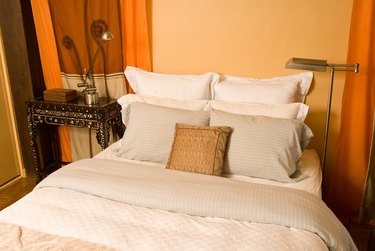Things You'll Need
Spray starch
Coordinating fabric
Fusible webbing
Collar stays
Sewing machine
Matching thread

Pillow shams are the backbone of the bed pillow assortment. Shams provide the central focal point for your bed collection, and a floppy edge is not what the sham is supposed to look like. Soft fabric, repeated washing, size of flange and edge trim can all cause the edges to fall forward. Correcting the problem can usually be accomplished with one or a combination of bedding maker tricks.
Step 1
Spray starch the flange, both back and front. Use heavy-duty spray starch and as high a heat as the sham fabric will accept. Spray starch can stick to the sole plate of your iron, so prevent this by using a pressing cloth. Spray the front flange evenly, press and allow to dry completely. Spray the back of the entire sham, press and allow it to dry. Spray a second or third time if necessary. Repeat starching is necessary if the sham is cleaned.
Video of the Day
Step 2
Adhere fabric to the entire back of the sham. Choose a coordinating fabric in a natural fiber and preshrink it if necessary. A natural fiber can withstand the high heat required for a complete adhesion.
Construct a back 1/4-inch smaller than the size of the front of the sham, with an opening that allows the sham to be accessed. Add 1 inch to the required finished width and length for seam allowances. Turn the edges of the false back under 1/2 inch on all sides and stitch.
Fuse the fabric to the back of the sham with fusible webbing by following the directions for your brand of webbing. Not all webbings are applied the same way.
Step 3
Stitch around the perimeter of the sham flange at 1/4-inch increments. Start sewing the rows 1/4 inch from the outside edge, and continue for two rows past the seam that separates the flange from the sham. This decreases the pillow space by 1 inch, but provides additional support for the flange.
Step 4
Stitch channels in the corners of the flange, from the outside edge to the inner flange seam. Stitch two stitches beyond the seam and the back tack stitch. Turn the sham inside out, and open the seam between the flange and sham at the channels. Insert a shirt collar stay into the channel.
Turn the sham right side out and stitch the channels closed. Sew the channels to the required width of the collar stays, which you can purchase in fashion fabric stores. Sew additional channels across the flange and add stays as required
Tip
If constructing shams, add several layers of iron-on interfacing to the wrong side of back of the sham to provide a strong base for the flange.
Video of the Day